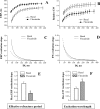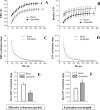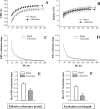Effects of Na+ channel blockers on the restitution of refractory period, conduction time, and excitation wavelength in perfused guinea-pig heart
- PMID: 28231318
- PMCID: PMC5322976
- DOI: 10.1371/journal.pone.0172683
Effects of Na+ channel blockers on the restitution of refractory period, conduction time, and excitation wavelength in perfused guinea-pig heart
Abstract
Na+ channel blockers flecainide and quinidine can increase propensity to ventricular tachyarrhythmia, whereas lidocaine and mexiletine are recognized as safe antiarrhythmics. Clinically, ventricular fibrillation is often precipitated by transient tachycardia that reduces action potential duration, suggesting that a critical shortening of the excitation wavelength (EW) may contribute to the arrhythmic substrate. This study examined whether different INa blockers can produce contrasting effects on the rate adaptation of the EW, which would explain the difference in their safety profile. In perfused guinea-pig hearts, effective refractory periods (ERP), conduction times, and EW values were determined over a wide range of cardiac pacing intervals. All INa blockers tested were found to flatten the slope of ERP restitution, indicating antiarrhythmic tendency. However, with flecainide and quinidine, the beneficial changes in ERP were reversed owing to the use-dependent conduction slowing, thereby leading to significantly steepened restitution of the EW. In contrast, lidocaine and mexiletine had no effect on ventricular conduction, and therefore reduced the slope of the EW restitution, as expected from their effect on ERP. These findings suggest that the slope of the EW restitution is an important electrophysiological determinant which can discriminate INa blockers with proarrhythmic and antiarrhythmic profile.
Conflict of interest statement
Figures






References
-
- Roden DM, Anderson ME (2006). Proarrhythmia. Handb Exp Pharmacol 171:73–97. - PubMed
-
- Coplen SE, Antman EM, Berlin JA, Hewitt P, Chalmers TC (1990). Efficacy and safety of quinidine therapy for maintenance of sinus rhythm after cardioversion. A meta-analysis of randomized control trials. Circulation 82: 1106–1116. - PubMed
-
- Flaker GC, Blackshear JL, McBride R, Kronmal RA, Halperin JL, Hart RG (1992). Antiarrhythmic drug therapy and cardiac mortality in atrial fibrillation. The Stroke Prevention in Atrial Fibrillation Investigators. J Am Col Cardiol 20: 527–532. - PubMed
MeSH terms
Substances
LinkOut - more resources
Full Text Sources
Other Literature Sources

